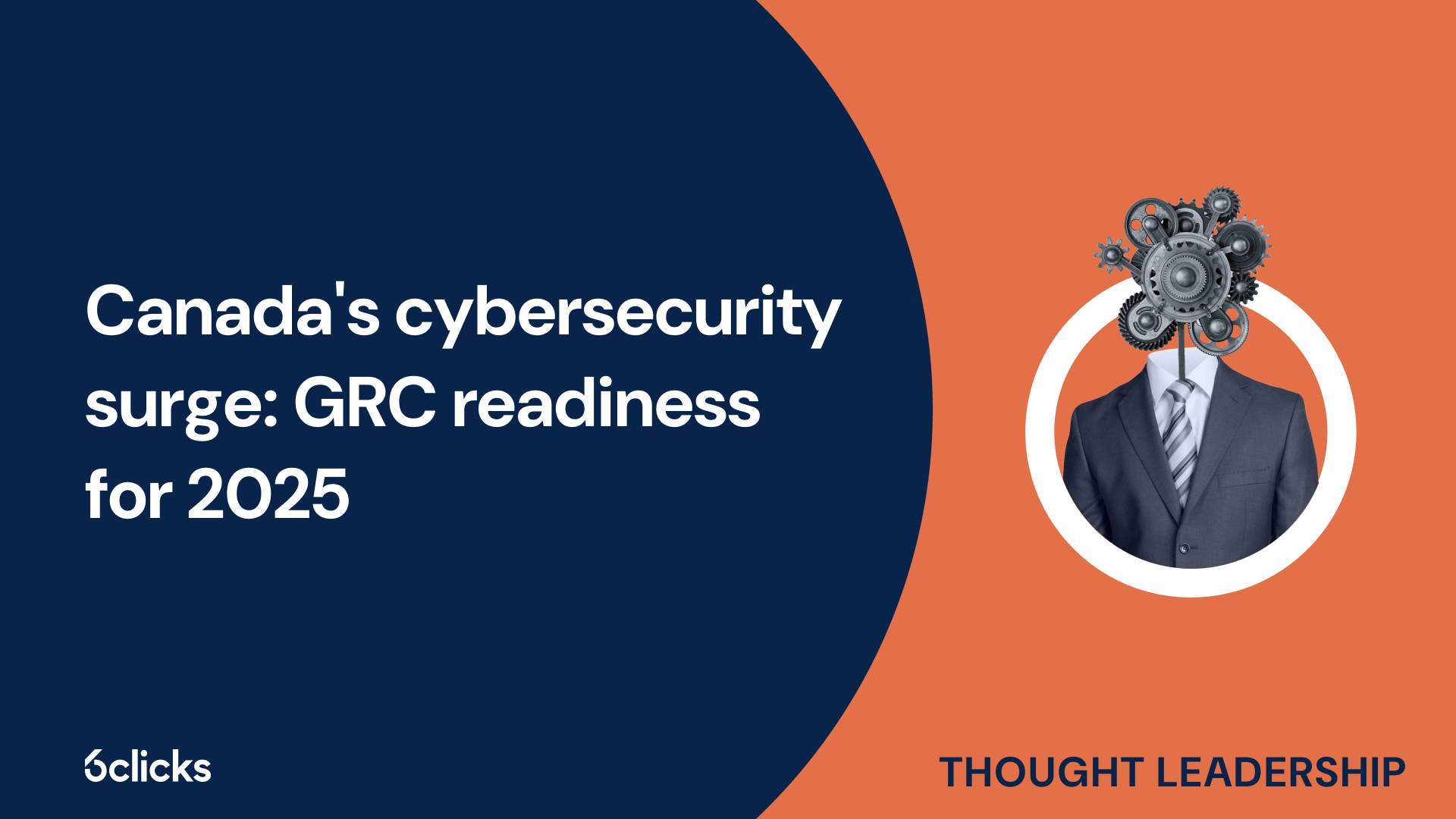
Canada’s cyber threat landscape is intensifying, with state-sponsored actors, ransomware, and AI-driven attacks putting critical infrastructure and sensitive data at risk. At the same time, organizations face mounting regulatory pressure around ITSG-33, data residency, and privacy laws. This blog explores why traditional GRC approaches are falling short — and how AI-powered platforms can help Canadian organizations shift from reactive compliance to proactive resilience. Read on to learn more.
The current state of Canadian cybersecurity threats

Canadian organizations face an unprecedented cybersecurity landscape. The Canadian Centre for Cyber Security's National Cyber Threat Assessment 2025-2026 highlights how state-sponsored threat actors have grown more assertive and ambitious, extending to espionage and cyber and OT attacks and identifying ransomware as the most disruptive threat facing Canada's critical infrastructure.
The report also outlines several key trends expected to shape the cyber threat landscape through 2026: adversaries leveraging AI technologies to amplify attacks, growing reliance on common vendors and platforms that heighten systemic risk, and the dual use of commercial technologies for both civilian and military purposes turning them into cyber battlegrounds. This reality demands a fundamental shift in how Canadian organizations approach cybersecurity governance, risk management, and compliance.
Why traditional GRC approaches are failing in 2025
With today's dynamic threat environment, legacy GRC systems built for static compliance checkboxes cannot keep pace. Traditional frameworks operate in silos, creating blind spots where risks multiply undetected. According to recent industry surveys, 68% of Canadian organizations still rely on manual processes and spreadsheet-based risk assessments that update quarterly at best.
The disconnect between risk identification and response capabilities proves especially problematic. While threats evolve in real-time, traditional GRC programs operate on annual review cycles. This temporal mismatch leaves organizations perpetually reactive, addressing yesterday's risks while tomorrow's threats exploit current vulnerabilities.
Furthermore, the complexity of modern regulatory requirements—including privacy laws and sector-specific mandates—overwhelms traditional compliance tracking methods. Organizations managing multiple frameworks report spending 40% more time on compliance activities while achieving 30% less risk coverage than those using integrated GRC frameworks.
Building AI-enhanced GRC frameworks for Canadian organizations
Artificial intelligence transforms GRC from reactive compliance to proactive risk intelligence. AI-powered GRC platforms equip Canadian organizations with supercharged automation to reduce manual work and errors, improve accuracy, and enable prompt detection and response to threats. Key capabilities include:
-
AI-powered control mapping and gap analysis across Canadian and global frameworks like ITSG-33, ISO/IEC 27001, SOC 2, and more
-
Automated risk and issue extraction from assessments and vendor security reviews
-
Automated remediation and treatment plans based on compliance requirements
-
Instant insights, task execution, and access to critical GRC data

Integration capabilities also prove crucial for Canadian organizations managing complex technology stacks. Modern AI-GRC platforms like 6clicks seamlessly connect with existing security tools, creating unified dashboards that provide real-time visibility across all risk domains.
ITSG-33 compliance and data residency requirements

The Information Technology Security Guidance (ITSG-33) framework remains central to Canadian federal government security requirements, and its influence is expanding to private sector organizations that handle sensitive or government-linked data. ITSG-33’s risk-based approach aligns well with modern GRC platforms, enabling dynamic control selection based on actual threat levels rather than static checklists.
Data residency requirements add another layer of complexity, particularly for organizations operating across provinces or serving government clients. Federal standards and provincial laws mandate that certain categories of information remain within Canadian borders, requiring careful architectural planning. Cloud-based GRC solutions must therefore provide Canadian data centres and guarantee data locality throughout the processing and storage lifecycle.
Organizations implementing ITSG-33 with modern GRC platforms have reported up to a 50% reduction in assessment timelines alongside significantly improved control effectiveness. By automating control testing and evidence collection, compliance shifts from a periodic exercise to a model of continuous assurance.
Implementing continuous risk monitoring and exposure management
Continuous risk monitoring represents the evolution from point-in-time assessments to real-time risk intelligence. Instead of discovering control failures during annual reviews, modern GRC platforms integrate with tools like SIEMs, vulnerability scanners, and threat intelligence feeds to maintain current risk profiles.
Key elements include:
-
Integration with security systems – Connecting SIEMs, vulnerability scanners, and threat feeds ensures immediate detection of control failures.
-
Exposure management – Goes beyond traditional vulnerability management by correlating technical issues with business impact and threat actor behavior to prioritize remediation. Some Canadian healthcare organizations using exposure management have reported up to 80% faster remediation of critical vulnerabilities.
-
Dynamic risk scoring – Risk scores automatically adjust when new vulnerabilities or targeted campaigns emerge, triggering updates to registers, treatment plans, and response protocols.
This shift from static to continuous monitoring is critical for Canada’s interconnected critical infrastructure sectors, where real-time responsiveness can make the difference between resilience and disruption.
Strategic roadmap: From reactive to proactive cybersecurity governance
Transforming cybersecurity governance requires a structured roadmap that balances immediate needs with long-term resilience. For Canadian organizations, success means embedding AI, data residency, and continuous monitoring into every stage of their GRC journey.

Phase one: Establishing the foundation
The first step is implementing an integrated AI-powered GRC platform to unify risk registers, automate compliance workflows, and reduce spreadsheet reliance. Ensure data residency compliance by selecting platforms such as 6clicks that host data in Canadian cloud environments — across private, public, dedicated, or government options — to maintain data locality throughout processing and storage.
Phase two: Integrating intelligence and automation
Connect with SIEMs, vulnerability scanners, and threat intelligence feeds to maintain real-time risk profiles. Deploy AI-driven detection and remediation workflows to spot patterns beyond human analysis and enable proactive response. Outcomes include reduced mean time to detect (MTTD) and mean time to respond (MTTR), with some organizations reporting up to 80% faster remediation for critical vulnerabilities.
Phase three: Embedding proactive governance
The final phase involves embedding proactive governance into organizational culture through continuous improvement programs. This includes regular tabletop exercises, control optimization based on effectiveness data, and integrating cybersecurity governance with broader business strategy. Mature governance programs have shown up to 70% fewer security incidents and 40% lower compliance costs.
Conclusion: Building resilience for Canada’s digital future
Canada’s cyber threat environment is evolving faster than traditional governance models can keep up. State-sponsored actors, ransomware groups, and the growing use of AI in attacks all underscore the need for a shift from reactive compliance to proactive governance.
By adopting AI-powered GRC platforms, aligning with frameworks like ITSG-33, addressing data residency requirements, and implementing continuous risk monitoring, Canadian organizations can move beyond outdated checklists and siloed processes. The strategic roadmap outlined here shows how immediate gains in visibility and automation can evolve into long-term resilience, cultural maturity, and measurable reductions in both incidents and compliance costs.
The path forward is clear: organizations that act now to modernize their GRC programs will not only meet regulatory expectations but also strengthen their ability to thrive in an increasingly complex and interconnected digital economy.
Take the next step toward proactive cybersecurity governance with 6clicks.


